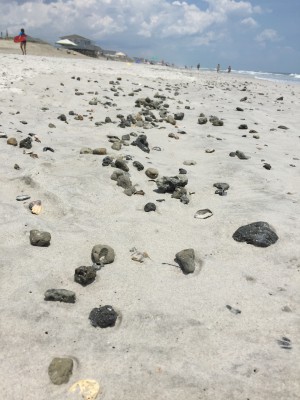NORTH TOPSAIL BEACH – Rocks strewn on the southern end of North Topsail Beach’s ocean shoreline have been picked up, as directed by the Army Corps of Engineers.

The town earlier this month hired C.M. Mitchell Construction to mechanically remove rocks on the surface of and upwards of four inches below the sand throughout about a 3-mile stretch of beach that begins at the town line with Surf City.
Supporter Spotlight
About nine to 10 yards of rock debris was removed from the beach, according to Town Clerk Laura Oxley. The three-day, $28,000 job wrapped April 13, well before the May 1 deadline that coincides with the start of sea turtle nesting season.
This marks the third time federal and state wildlife officials have directed rock removal since a beach re-nourishment project that wrapped up in 2015 inadvertently pumped tons of rocks onto the southernmost end of the shoreline.
Regulatory agencies this year expanded the rock-picking requirement an additional one mile north of what is referred to as the “Phase 5” project area. Rocky debris within small areas of that mile-long stretch had to be hand-picked from the toe of the dune line, a job done by town staff.
Town officials were notified April 5 that rocks would again need to be picked off the beach throughout the Phase 5 project area, despite appeals from Ken Willson, project manager with Coastal Planning & Engineering Inc., a consultant firm to the town.
Willson told town aldermen during an April 5 meeting that sea turtles have been nesting successfully in the Phase 5 area.
Supporter Spotlight
He said that the rocks on the beach are a natural occurrence, washed ashore from the depths of Onslow Bay, which has an abundance of rock bottom.
“There’s no reason to do rock picking this year,” Willson said. “We were pretty aggravated with that.”
Federal and state wildlife officials say the rock removal requirement is a precaution to ensure female sea turtles will not be deterred from nesting on that portion of the beach.
Rock removal has equated to successful nesting seasons, said Matthew Godfrey, sea turtle biologist with the North Carolina Wildlife Resources Commission.
After various weather and mechanical delays, North Topsail’s Phase 5 beach nourishment project was completed June 30, 2015.
That year, five sea turtle nests were laid successfully within the 3.5-mile project area, Godfrey said.
Thirty-six nests were found within that same stretch of beach in 2016.
Last year, 17 sea turtle nests were laid within the Phase 5 area.

Wildlife officials like the outcome they’ve seen thus far, Godfrey said.
“We’re concerned that the higher density of rock on the beach in that area will dissuade females from nesting” he said. “We don’t want that to occur. We’re not arguing that turtles will never nest in a rocky area. We are arguing that the presence of rocks may dissuade them from nesting in those areas.”
North Topsail Beach is one of three beach towns on Topsail Island, which stretches 26 miles. The island’s beaches are federally designated critical habitat for the threatened loggerhead sea turtle.
“Topsail Island in general is a high-density nesting beach for sea turtles,” said Kathy Matthews, a fish and wildlife biologist with the U.S. Fish & Wildlife Service’s Raleigh field office
Between 2004 and 2014, the rate sea turtle nesting rate on the island was 3.8 nests per mile, Godfrey said.
In 2015, the rate was 3.1 nests per mile.
“If you look at the project area in 2015 it was 1.4, so way down,” Godfrey said. “By having the town remove as much as rock as possible they make the habitat more suitable for nesting.”
The rocks were initially uncovered by winter storms in late January and early February 2015, about two months after a dredge began pumping sand from a site along the ocean floor onto the town’s southernmost beach.
Rather than halt the project, regulatory agencies agreed to allow work to continue as long as contractors abided by a rock remediation plan that included setting up boxes to catch rocks being pumped from the ocean floor and picking up rocks already on and beneath the sand.
The town of Oak Island ran into a similar problem during a re-nourishment project in 2000.
Godfrey said that officials have learned from that project that residual rocks from that project move to other areas of the beachfront.
Matthews said that it is difficult to pinpoint the source of the rocks in the Phase 5 project area.
“It’s hard to quantify what that is,” she said. “There’s still quite a bit of material in the dune. There’s still some material just below the water line. (Godfrey) and I felt the material was an amount that might deter sea turtle nesting. We don’t want to leave it there and see what happens.”







